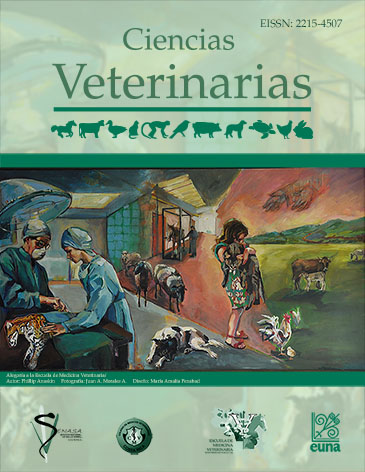Fungal keratitis in a mare: case report in Costa Rica
DOI:
https://doi.org/10.15359/rcv.38-2.3Abstract
This paper discusses the diagnosis and clinical management of a case of equine keratomycosis. A pregnant Iberic mare was diagnosed with Aspergillus subgenus Circumdati section Circumdati, by direct microscopic examination, cytology, and fungal culture after being treated with a topical antibiotic and steroid drops in her left eye for over a month. The mare developed a melting ulcer and, as a result, topical miconazole 1% was prescribed; while being treated the iris prolapsed, and surgery was suggested but not conducted. After the treatment, the eye was not visual but in the orbit.
References
Barnett, K.C., Crispin, S.M., Lavach, J.D. & Matthews, A.G. (eds.). 2004. Equine Ophthalmology: An Atlas and Text, 2nd Edition. Saunders Elsevier, Oxford. p. 107-147.
Brooks, D.E., Plummer, C.E., Mangan, B.G. & Ben-Shlomo, G. 2013. Equine subepithelial keratomycosis. Vet. Ophthalmol. 16(2): 93–96. doi: 10.1111/j.1463-5224.2012.01031.x
Cafarchia, C., Figueredo, L.A. & Otranto, D. 2013. Fungal diseases of horses. Vet. Microbiol. 167(1-2): 215-234. doi: 10.1016/j.vetmic.2013.01.015
Calderón-Hernández, A. & Urbina-Villalobos, A. 2018. Veterinary mycosis in a tropical country. 20th Congress of the International Society for Human and Animal Mycology. Amsterdam, The Netherlands. Abstract, Med. Mycol. 56: S1-S159. doi: 10.1093/mmy/myy036
Clode, A.B. 2011. Diseases and surgery of the cornea. In: Gilger, BC (ed.). Equine Ophthalmology, 2nd Edition. Elsevier Saunders, Missouri. p. 181-266.
De Hoog, G.S., Guarro, J., Gené, J., Ahmed, S., Al-Hatmi, A.M.S, Figueras, M.J. & Vitale, R.G. 2019. Atlas of Clinical Fungi, 3rd e-edition. Utrecht/Reus.
Galán, A., Martín-Suárez, E.M., Gallardo, J.M. & Molleda, J.M. 2009. Clinical findings and progression of 10 cases of equine ulcerative keratomycosis (2004–2007). Equine Vet. Educ. 21(5): 236-242. doi: 10.2746/095777309X400289
Galera, P.D. & Brooks, D.E. 2012. Optimal management of equine keratomycosis. Vet. Med. (Auckl). 3: 7-17. doi: 10.2147/VMRR.S25013
Gilger, B.C. 2013. Equine Ophthalmology. In: Gelatt, K.N. (ed.). Veterinary Ophthalmology, 5th Edition. John Wiley & Sons, Iowa. p. 1560-1609.
Houbraken, J., Kocsubé, S., Visagie, C.M., Yilmaz, N., Wang, X.C, Meijer, M., Kraak, B., Hubka, V., Samson, R.A. & Frisvad, J.C. 2020. Classification of Aspergillus, Penicillium, Talaromyces and related genera (Eurotiales): An overview of families, genera, subgenera, sections, series, and species. Stud. Mycol. 95: 5-169. doi: 10.1016/j.simyco.2020.05.002
Khosravi, A.R., Nikaein, D., Sharifzadeh, A. & Gharagozlou, F. 2014. Ocular fungal flora from healthy horses in Iran. J. Mycol. Med. 24(1): 29-33. doi: 10.1016/j.mycmed.2013.10.006
Ledbetter, E.C. 2017. Antifungal therapy in equine ocular mycotic infections. Vet. Clin. N. Am. Equine. 33(3): 583-605. doi: 10.1016/j.cveq.2017.08.001
Ledbetter, E.C., Irby, N.L. & Teixeira, L.B.C. 2018. In vivo confocal microscopy characteristics of equine epithelial and subepithelial nonulcerative keratomycosis. Vet. Ophthalmol. 22(2):168-172. doi: 10.1111/vop.12576
Maggs, D.J. 2008. Cornea and sclera. In: Maggs, D.J., Miller P.E. & Ofri, R. (eds.). Slatter’s Fundamentals of Veterinary Ophthalmology, 4th Edition. Saunders-Elsevier, Missouri. p. 175-202.
Roberts, D., Cotter, H.V.T., Cubeta, M. & Gilger, B.C. 2020. In vitro susceptibility of Aspergillus and Fusarium associated with equine keratitis to new antifungal drugs. Vet. Ophthalmol. 23(5): 918-922. doi: 10.1111/vop.12774
Samanta, I. 2015. Veterinary Mycology. Springer India, New Dehli. p. 41, 155.
Samson, R.A., Houbraken, J., Thrane, U., Frisvad, J.C. & Andersen, D. 2019. Food and Indoor Fungi, 2nd Edition. Westerdijk Fungal Biodiversity Institute, Utrecht, The Netherlands. p. 39-41.
Sansom, J., Featherstone, H. & Barnett, K.C. 2005. Keratomycosis in six horses in the United Kingdom. Vet. Rec. 156(1): 13. doi: 10.1136/vr.156.1.13
Sherman, A.B., Clode, A.B. & Gilger, B.C. 2017. Impact of fungal species cultured on outcome in horses with fungal keratitis. Vet. Ophthalmol. 20(2): 140-146. doi: 10.1111/vop.12381
Utter, M.E., Wotman, K. L., Armour, M. & Bagel, J. 2010. Clinical findings and outcomes of ulcerative keratomycosis in 30 horses in the mid-Atlantic United State (2006–2007). Equine Vet. Educ. 22(1) 31-39. doi: 10.2746/095777309X478
Utter, M.E. & Brooks, D.E. 2011. Glaucoma. In: Gilger BC (ed.). Equine Ophthalmology, 2nd Edition. Elsevier Saunders, Missouri. p. 350-366.
Utter, M.E. 2015. Fungal keratitis. In: Sprayberry, K.A. & Robbinson, N.E. (eds.). Robbinson’s current therapy in equine medicine, 7th Edition. Elsevier, Missouri. p. 611-613.
Voelter-Ratson, K., Pot, S.A., Florin, M. & Spiess, B.M. 2013. Equine keratomycosis in Switzerland: A retrospective evaluation of 35 horses (January 2000–August 2011). Equine Vet. J. 45(5): 608-612. doi: 10.1111/evj.12042
Wada, S., Ode, H., Hobo, S., Niwa, H., Katayama, Y. & Takatori, K. 2011. Mortierella wolfii keratomycosis in a horse. Vet. Ophthalmol. 14(4): 267-270. doi: 10.1111/j.1463-5224.2011.00891.x
Wada, S., Hobo, S., Ode, H., Niwa, H. & Moriyama, H. 2013. Equine keratomycosis in Japan. Vet. Ophthalmol. 16(1): 1-9. doi: 10.1111/j.1463-5224.2012.01004.x
Walsh, T.J., Hayden, R.T. & Larone, D.H. 2018. Larone’s medically important fungi. A guide to identification, 6th Edition. ASM Press, Washington, D.C. p. 44-45, 293-308, 365.
Published
How to Cite
Issue
Section
License
Licensing of articles
All articles will be published under a license:

Licencia Creative Commons Atribución-NoComercial-SinDerivadas 3.0 Costa Rica.
Access to this journal is free of charge, only the article and the journal must be cited in full.
Intellectual property rights belong to the author. Once the article has been accepted for publication, the author assigns the reproduction rights to the Journal.
Ciencias Veterinarias Journal authorizes the printing of articles and photocopies for personal use. Also, the use for educational purposes is encouraged. Especially: institutions may create links to specific articles found in the journal's server in order to make up course packages, seminars or as instructional material.
The author may place a copy of the final version on his or her server, although it is recommended that a link be maintained to the journal's server where the original article is located.
Intellectual property violations are the responsibility of the author. The company or institution that provides access to the contents, either because it acts only as a transmitter of information (for example, Internet access providers) or because it offers public server services, is not responsible.







